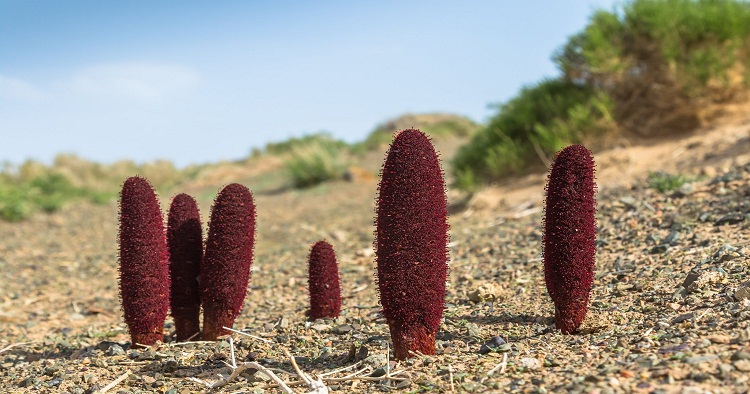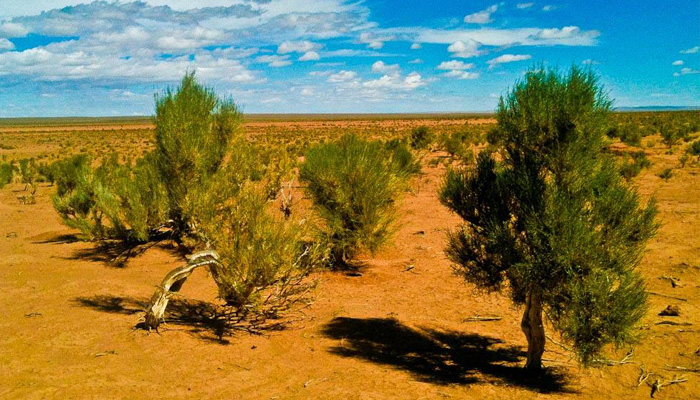Introduction
The Gobi Desert in Mongolia is one of the world’s most unique ecosystems, known for its extreme climate with hot summers, cold winters, and very little rainfall. Despite these harsh conditions, the desert is home to remarkable vegetation that has adapted to survive and thrive in such an arid environment. Among the most iconic Gobi Desert plants are the Goyo shrub (Amygdalus pedunculata), the Saxaul tree (Zag, Haloxylon ammodendron), and the Tooroi or Poplar tree (Populus diversifolia).
These plants are not only important for maintaining the ecological balance of the desert, but they also play a vital role in the lives of local communities, providing shelter, food, medicine, and protection against soil erosion. By studying the flora of the Gobi Desert, we can better understand how nature adapts to extreme conditions and why it is essential to conserve these valuable species.

Goyo (Amygdalus pedunculata)
The Goyo shrub (Amygdalus pedunculata), often called the “spring flower of the Gobi,” is one of the most symbolic plants of Mongolia’s desert regions. This low-growing shrub typically reaches 30–100 cm in height and is easily recognized by its delicate pinkish-white blossoms that bloom early in spring. As one of the first flowering plants of the Gobi Desert, Goyo brings life and color to the otherwise dry landscape.
From an ecological perspective, Goyo plays a vital role in protecting soil and preventing desertification. Its extensive root system helps stabilize sand dunes and reduce soil erosion caused by wind and water. In areas where vegetation is scarce, the presence of Goyo is critical for maintaining biodiversity and supporting the survival of smaller desert organisms.
Beyond its environmental importance, Goyo has also been valued in traditional Mongolian life. The plant’s roots and stems have been used in folk medicine for various treatments, while its blossoms are admired for their beauty and symbolism of renewal. Some local communities also consider Goyo to have spiritual meaning, representing resilience and harmony with nature.
By preserving and studying this plant, we not only protect the delicate balance of the desert ecosystem but also safeguard an important part of Mongolian cultural and natural heritage.

Saxaul Tree (Zag – Haloxylon ammodendron)
The Saxaul tree, known in Mongolia as Zag, is considered one of the most important woody plants of the Gobi Desert. Unlike many desert shrubs, Zag can grow into a small tree, making it a rare and valuable source of shade and stability in the arid landscape.
One of the most remarkable features of the Zag tree is its deep and extensive root system. These roots reach underground water sources, allowing the plant to survive extreme drought while also stabilizing soil and sand. By doing so, Zag plays a critical role in preventing desertification, reducing sandstorms, and protecting the fragile desert ecosystem.
For centuries, local herders and communities have relied on Zag wood as a source of fuel, since its dense branches burn well and produce long-lasting heat. This traditional use highlights its cultural and practical importance, though it has also led to concerns about overharvesting and the need for sustainable management.
Ecologically, the Saxaul tree is often described as the guardian of the Gobi Desert. By reducing wind erosion and supporting soil fertility, it provides shelter for smaller plants and animals. Without Zag, many parts of the Gobi would be more vulnerable to shifting sands and harsh winds.
Preserving and restoring Zag populations is essential not only for the survival of desert wildlife but also for the well-being of local people who depend on this tree. It stands as a symbol of resilience, protection, and ecological balance in Mongolia’s Gobi Desert.

Tooroi Tree (Poplar – Populus diversifolia / euphratica)
The Tooroi tree, a type of desert poplar (Populus diversifolia / euphratica), is one of the rarest and most valuable trees found in the Gobi Desert of Mongolia. Unlike the low shrubs that dominate the region, Tooroi can grow tall and strong, often reaching heights of 10–15 meters. These trees are most commonly found in oases and river valleys, where underground water sources are accessible.
The ecological importance of the Tooroi tree cannot be overstated. Acting as a natural water regulator, Tooroi helps maintain oasis ecosystems by drawing from deep groundwater reserves. This creates a habitat where numerous desert animals, birds, and insects can survive. In fact, Tooroi groves are often considered the lifeline of desert biodiversity, serving as shelter, nesting areas, and a source of balance in an otherwise dry environment.
For local communities, Tooroi has long been seen as more than just a tree. It is a symbol of life, endurance, and water in the middle of the desert. Mongolians often refer to it as the “living water tree of the Gobi”, highlighting its cultural and spiritual significance. In traditional life, Tooroi wood was occasionally used for construction or fuel, but its true value lies in its ability to preserve water sources and protect the delicate desert ecosystem.
Today, conservation of Tooroi trees is a priority, as overharvesting, desertification, and climate change threaten their survival. Protecting these trees means protecting the future of Mongolia’s Gobi Desert, ensuring that both nature and people continue to benefit from their presence.
Comparison and Shared Importance of Goyo, Saxaul, and Tooroi
Although the Goyo shrub, Saxaul tree, and Tooroi poplar differ in appearance and habitat, they share a common role as the foundation of the Gobi Desert ecosystem. Each plant has developed unique adaptations to survive the extreme climate, yet together they provide stability, biodiversity, and life to Mongolia’s desert regions.
- Soil and Sand Protection:
- The Goyo shrub stabilizes sand dunes with its wide root network.
- The Saxaul tree (Zag) anchors the soil deeply, reducing sandstorms and desertification.
- The Tooroi tree preserves moisture and prevents soil erosion in oasis areas.
Collectively, these plants are essential for protecting fragile desert soils and combating land degradation.
- Creating Habitats for Wildlife:
- Tooroi trees provide shade, nesting sites, and a water-linked environment for birds and mammals.
- Zag groves shelter smaller desert species from wind and heat.
- Goyo shrubs support insects and ground-dwelling animals.
By maintaining micro-habitats, these plants ensure the survival of countless desert organisms.
- Human and Livestock Value:
- Local herders use Zag wood as fuel and Goyo for traditional medicine.
- Tooroi oases are vital grazing areas where animals find relief during harsh summers.
- All three plants represent sources of survival, resilience, and balance for desert communities.
In short, Goyo, Saxaul, and Tooroi are not just plants, but lifelines of the Gobi Desert. They safeguard the land, nurture wildlife, and support human life. Preserving them means protecting the cultural heritage and ecological balance of Mongolia’s Gobi Desert for generations to come.
Conservation and Challenges
Despite their ecological and cultural importance, Goyo, Saxaul (Zag), and Tooroi trees face increasing threats in the Gobi Desert. Overharvesting, desertification, and climate change are among the main challenges that have led to the decline of these vital plants.
- Overuse by Humans:
- Saxaul wood is traditionally used as fuel, and excessive cutting can lead to the loss of these critical desert guardians.
- Goyo shrubs are sometimes collected for medicinal purposes, which can disturb natural regeneration.
- Tooroi trees are vulnerable to cutting near oasis areas for construction or firewood.
- Climate Change and Desertification:
- Rising temperatures and prolonged droughts reduce survival rates of these species.
- Soil erosion and shifting sand dunes threaten plant habitats, making natural regeneration difficult.
- Conservation and Restoration Efforts:
- Reforestation and planting projects aim to restore Saxaul and Tooroi populations.
- Protecting Goyo shrubs and regulating their use ensures long-term survival.
- Local and national initiatives focus on sustainable grazing, controlled harvesting, and awareness campaigns to highlight the ecological value of these plants.
Preserving these plants is crucial not only for maintaining the ecological balance of the Gobi Desert but also for sustaining the livelihoods of local communities and protecting Mongolia’s natural heritage. Effective conservation ensures that future generations can continue to benefit from the desert’s unique flora.
Conclusion
The Goyo shrub, Saxaul (Zag) tree, and Tooroi poplar are more than just plants in the Gobi Desert of Mongolia; they are integral to the country’s culture, ecology, and daily life. These unique species have adapted to survive extreme desert conditions, providing soil stabilization, habitat for wildlife, and essential resources for local communities.
Beyond their ecological role, these plants hold cultural and symbolic significance. The Goyo flower marks the arrival of spring and renewal, the Saxaul tree represents resilience and protection against the harsh desert winds, and the Tooroi tree symbolizes life and water in the arid landscape. Together, they are living testaments to Mongolia’s deep connection between nature and human life.
Protecting and preserving these plants is essential not only for maintaining the ecological balance of the Gobi Desert but also for safeguarding Mongolia’s cultural heritage. By understanding and appreciating the roles of Goyo, Saxaul, and Tooroi, we can ensure that the desert’s unique flora continues to thrive for generations to come.
FAQ – Gobi Desert Plants (Goyo, Saxaul, Tooroi)
What is the importance of the Goyo plant?
The Goyo shrub (Amygdalus pedunculata) is one of the first flowering plants in the Gobi Desert. It helps stabilize sand dunes, protect soil from erosion, and supports local biodiversity. Additionally, Goyo has been used in traditional medicine and symbolizes spring and renewal in Mongolian culture.
Why is the Saxaul (Zag) tree considered a symbol of the Gobi Desert?
The Saxaul tree (Haloxylon ammodendron) is essential for preventing desertification, reducing sandstorms, and protecting the fragile desert ecosystem. Its deep roots and resilience make it a cultural and ecological symbol of survival and stability in Mongolia’s harsh desert environment.
Where does the Tooroi tree grow?
The Tooroi tree (Populus diversifolia / euphratica) thrives in oases and river valleys of the Gobi Desert where groundwater is accessible. It creates vital habitats for birds, mammals, and other wildlife, acting as a natural water regulator in arid landscapes.
Why is it important to protect Gobi Desert plants?
Protecting Gobi Desert plants like Goyo, Saxaul, and Tooroi is crucial to prevent desertification, preserve soil, maintain biodiversity, and support local communities. Conservation ensures that the ecological balance of the desert and Mongolia’s natural heritage is safeguarded for future generations.
What are the differences between Goyo, Saxaul, and Tooroi?
Goyo: Low-growing shrub, early spring flowers, soil stabilizer, medicinal uses.
Saxaul (Zag): Small tree, deep roots, prevents sandstorms, used for fuel.
Tooroi (Poplar): Tall tree, grows near water sources, provides wildlife habitat, symbolizes life and water in the desert.